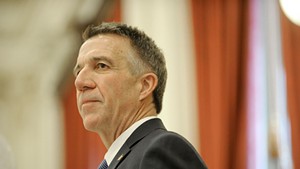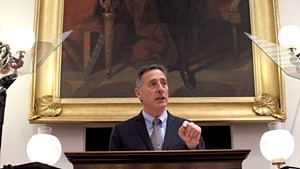Updated at 5:53 p.m. on November 24, 2020.
Vermont is moving state employees’ health plans to OneCare Vermont amid a planned reboot of its all-payer system aimed at increasing participation among patients and providers.
Effective January 1, the shift affects about 9,000 members of the Vermont State Employees' Association and Vermont Troopers’ Association, according to state Human Resources Commissioner Beth Fastiggi. About 6,000 retired state workers are already enrolled in the system through a Medicare plan, she said.
“The more participants in the plan, the more effective it can be in helping the effort to stop the increasing costs of health care,” Fastiggi said.
OneCare is Vermont’s only accountable care organization and manages the state’s all-payer health care system. Through a federal-state partnership, OneCare collects money from Medicare, Medicaid and private insurers to pay health care providers for each patient they treat instead of for each test, visit and procedure, which experts say drives up the cost of care.
Ditching the traditional fee-for-service system has taken longer than expected. Since OneCare launched in 2017, the state has fallen short of federal benchmarks called "scale targets" that dictate how many Vermonters should participate each year. The goal is for 70 percent of residents to be included by 2022.
By the end of this year, the target is 58 percent of Vermonters, but it’s likely that only 42 percent will be enrolled, according to Ena Backus, the state’s director of health care reform.
In September, the federal Centers for Medicare & Medicaid Services issued the state a warning letter for falling short of expectations. Including state employees in OneCare is an attempt to address those concerns, Backus said.
The shift will not change employees’ benefits, including premiums or co-pays, according to Fastiggi.
“Most employees really may not notice any difference whatsoever,” she said, noting that doctors may end up calling their patients more regularly to check in. “The goal is for [patients] to receive better quality care … and that’s why I completely support this move.”
VSEA executive director Steve Howard said the union’s bargaining teams will review the change to determine whether it impacts workers’ benefits. If they find it does, the union would demand a bargaining session, Howard said.
“The union is going to be very vigorous about making sure we protect the benefits that have been negotiated, the fiscal health of the plan,” he said. “State employees are not paid a lot of money. We don’t want to see any potential increases in costs to them.”
Howard said a number of members have voiced concerns about OneCare, but the union has reassured them that they still have health insurance. The state has also offered to meet with union representatives to discuss the change, he said.
Vermont is currently in year three of a five-year experiment with all-payer and OneCare. Its under-performance has caused some groups, including the Vermont Workers Center and Vermont Health Care for All,
to call on Gov. Phil Scott to dump OneCare in favor of a universal, single-payer health care system.
But state officials say they want to reboot the model, not can it.
The state released a report Thursday that outlines several steps to get the program on track — including working with the feds to determine if the benchmarks “are indeed achievable,” Backus said. The report includes recommendations for every player in the all-payer game: the Agency of Human Services, Green Mountain Care Board and OneCare itself.
“We need to take some ownership of this and lead on this to make it work,” said Scott spokesperson Ethan Latour, adding, “The amount of value the accountable care organization is adding to the reform efforts is mixed, depending on who you ask.”
Backus said the state wants OneCare to step up its recruitment to attract more providers to the model. It also needs to support providers who have already signed on, she said.
The state in particular has heard complaints about Care Navigator, an online platform that allows doctors to share patient information and coordinate care — one of the hallmarks of an all-payer system, Backus said. But only some types of providers can access the platform; others have reported that it’s not useful, she said.
“We think that the care coordination platform is extremely important … so how can we improve it?” Backus asked. “That’s the spirit of this assessment.”
OneCare CEO Vicki Loner on Thursday said she’s heard similar complaints from providers. Part of the challenge, Loner said, is that Care Navigator is used by a diverse group of doctors, all across the state. The platform is customizable but “it’s going to be hard to make it perfect for everybody,” she said.
Care Navigator also feeds data to providers — such as lists of patients who haven’t had a checkup recently or those with chronic conditions — which doctors can use to schedule preventative care appointments. Some providers, however, have said the system is confusing and doesn’t help them treat their patients. The state’s report asks OneCare to offer doctors technical support so that they’ll be encouraged to use the platform.
“Some resistance to change is to be expected, however widespread critique of the most basic tools … suggests that OneCare has not responded quickly enough to address participant feedback,” the report says.
Loner disputed that characterization. She said OneCare wants to improve its data services but can only do so if insurance companies provide data in a timely manner.
“It’s one of those things that requires all parts to work correctly,” she said.
Green Mountain Care Board chair Kevin Mullin agreed that every player needs to be “rowing in the same direction” for all-payer to succeed. For the care board, that means better marketing the model to hospitals and doctors, some of whom still remain skeptical, even as federal regulators have shown a desire to move away from fee-for-service.
Mullin said some health care workers also aren’t convinced that the Scott administration is behind all-payer. The report — and Human Services Secretary Mike Smith’s full-throated endorsement of all-payer in recent months — should change their minds, he said.
“Secretary Smith made it very, very clear that the state of Vermont not only supports a move away from volume to value [of care] but is going to take an active role in making sure we get there,” Mullin said. “I think it’s very encouraging.”
AHS will issue quarterly progress reports on the reform effort, Smith said at a press briefing Thursday.
“If we do this in a mindful way, we will have a system that other states and perhaps the federal government will emulate,” he said. “I understand we’ve had this fee-for-service system forever. That doesn’t mean we’re going to have it in the future.”

















Comments
Comments are closed.
From 2014-2020, Seven Days allowed readers to comment on all stories posted on our website. While we've appreciated the suggestions and insights, right now Seven Days is prioritizing our core mission — producing high-quality, responsible local journalism — over moderating online debates between readers.
To criticize, correct or praise our reporting, please send us a letter to the editor or send us a tip. We’ll check it out and report the results.
Online comments may return when we have better tech tools for managing them. Thanks for reading.